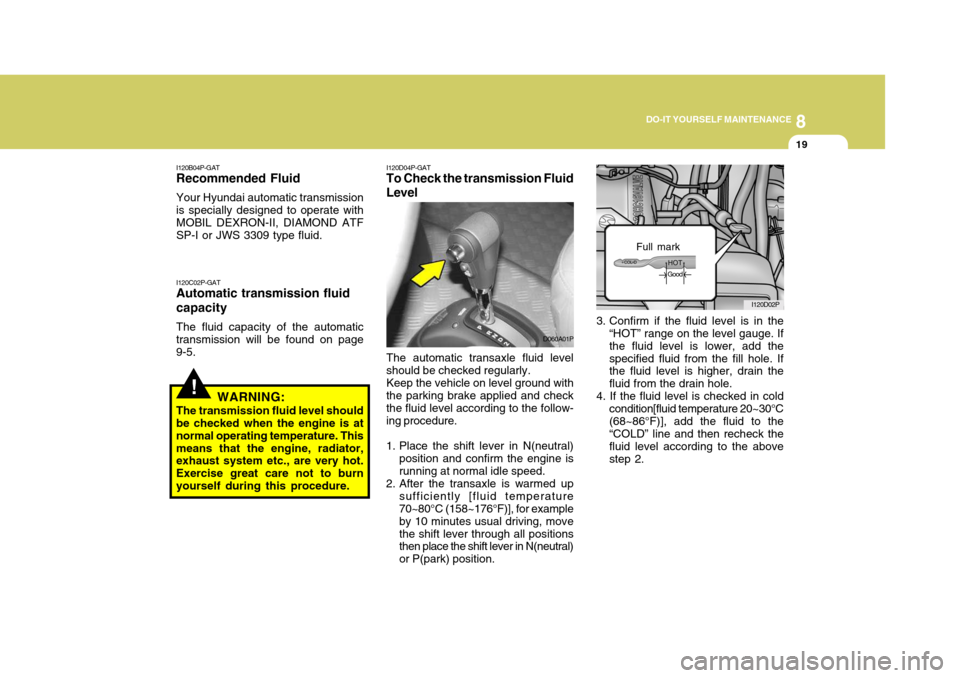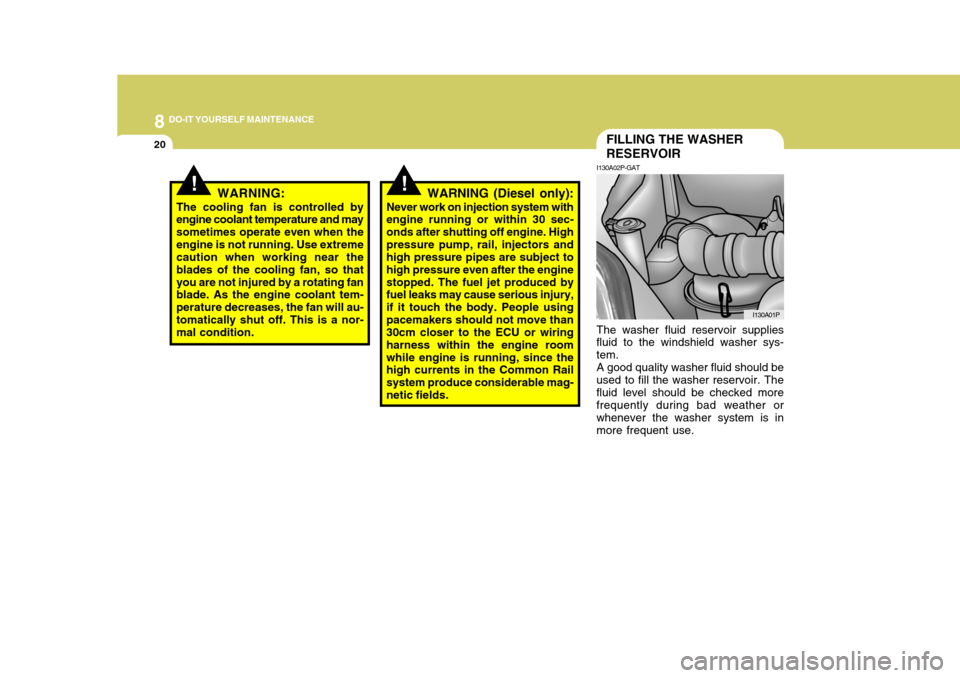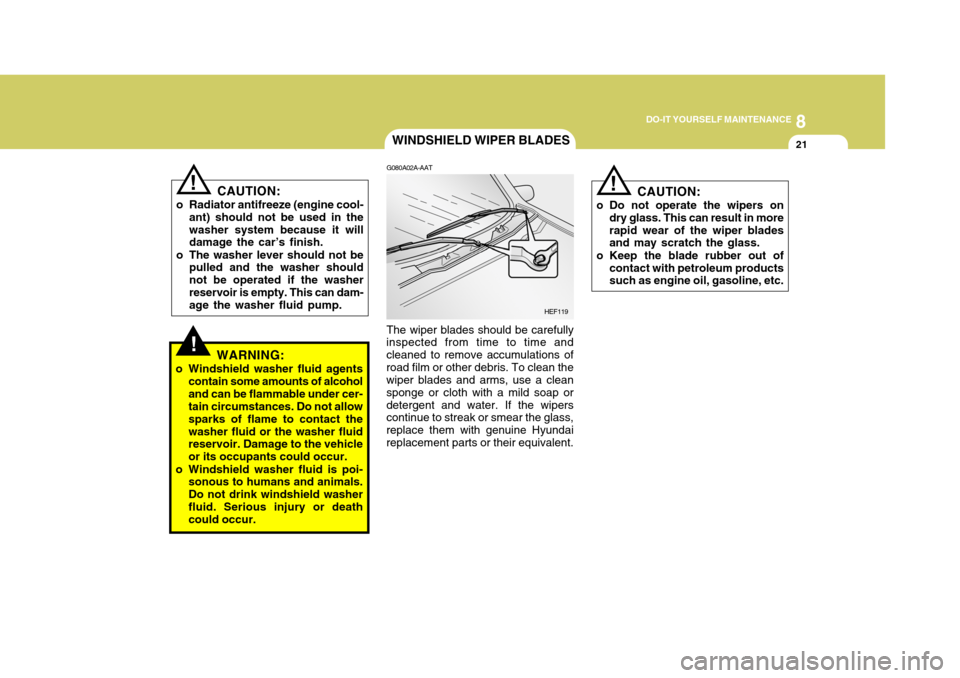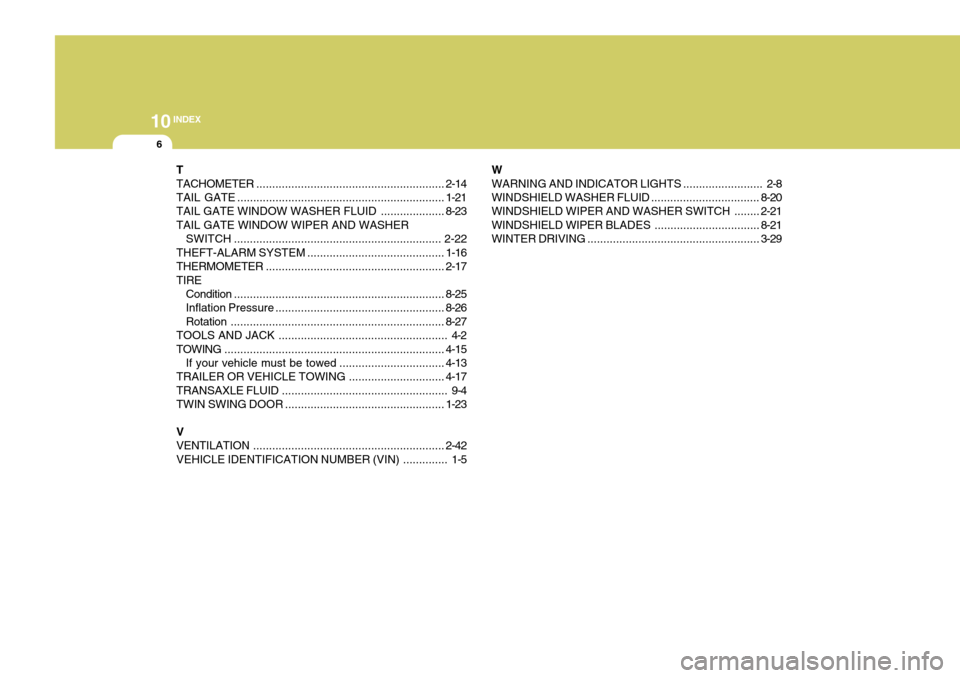2007 Hyundai H-1 (Grand Starex) warning
[x] Cancel search: warningPage 263 of 284

8
DO-IT YOURSELF MAINTENANCE
19
3. Confirm if the fluid level is in the
“HOT” range on the level gauge. If the fluid level is lower, add thespecified fluid from the fill hole. If the fluid level is higher, drain the fluid from the drain hole.
4. If the fluid level is checked in cold condition[fluid temperature 20~30°C(68~86°F)], add the fluid to the “COLD” line and then recheck the fluid level according to the abovestep 2. Full mark
I120D04P-GAT
To Check the transmission Fluid Level
The automatic transaxle fluid level
should be checked regularly.
Keep the vehicle on level ground with
the parking brake applied and check the fluid level according to the follow- ing procedure.
1. Place the shift lever in N(neutral) position and confirm the engine is running at normal idle speed.
2. After the transaxle is warmed up sufficiently [fluid temperature70~80°C (158~176°F)], for example by 10 minutes usual driving, movethe shift lever through all positions then place the shift lever in N(neutral) or P(park) position. D060A01P
I120D02P
!
I120B04P-GAT Recommended Fluid Your Hyundai automatic transmission is specially designed to operate with MOBIL DEXRON-II, DIAMOND ATF SP-I or JWS 3309 type fluid. I120C02P-GAT Automatic transmission fluid capacity The fluid capacity of the automatic transmission will be found on page9-5.
WARNING:
The transmission fluid level should be checked when the engine is at normal operating temperature. Thismeans that the engine, radiator, exhaust system etc., are very hot. Exercise great care not to burnyourself during this procedure.
Good
Page 264 of 284

8DO-IT YOURSELF MAINTENANCE
20
!WARNING:
The cooling fan is controlled by engine coolant temperature and may sometimes operate even when theengine is not running. Use extreme caution when working near the blades of the cooling fan, so thatyou are not injured by a rotating fan blade. As the engine coolant tem- perature decreases, the fan will au-tomatically shut off. This is a nor- mal condition.
FILLING THE WASHER RESERVOIR
I130A02P-GAT The washer fluid reservoir supplies
fluid to the windshield washer sys- tem.
A good quality washer fluid should be
used to fill the washer reservoir. Thefluid level should be checked more frequently during bad weather or whenever the washer system is inmore frequent use.
!WARNING (Diesel only):
Never work on injection system with engine running or within 30 sec- onds after shutting off engine. Highpressure pump, rail, injectors and high pressure pipes are subject to high pressure even after the enginestopped. The fuel jet produced by fuel leaks may cause serious injury, if it touch the body. People usingpacemakers should not move than 30cm closer to the ECU or wiring harness within the engine roomwhile engine is running, since the high currents in the Common Rail system produce considerable mag-netic fields. I130A01P
Page 265 of 284

8
DO-IT YOURSELF MAINTENANCE
21
!
WINDSHIELD WIPER BLADES
CAUTION:
o Do not operate the wipers on dry glass. This can result in more rapid wear of the wiper blades and may scratch the glass.
o Keep the blade rubber out of contact with petroleum productssuch as engine oil, gasoline, etc.
G080A02A-AAT The wiper blades should be carefully
inspected from time to time and cleaned to remove accumulations ofroad film or other debris. To clean the wiper blades and arms, use a clean sponge or cloth with a mild soap ordetergent and water. If the wipers continue to streak or smear the glass, replace them with genuine Hyundaireplacement parts or their equivalent. HEF119
CAUTION:
o Radiator antifreeze (engine cool- ant) should not be used in thewasher system because it will damage the car’s finish.
o The washer lever should not be pulled and the washer should not be operated if the washerreservoir is empty. This can dam- age the washer fluid pump.
!
!WARNING:
o Windshield washer fluid agents contain some amounts of alcohol and can be flammable under cer- tain circumstances. Do not allow sparks of flame to contact thewasher fluid or the washer fluid reservoir. Damage to the vehicle or its occupants could occur.
o Windshield washer fluid is poi- sonous to humans and animals.Do not drink windshield washerfluid. Serious injury or death could occur.
Page 270 of 284

8DO-IT YOURSELF MAINTENANCE
26
Vehicle
MINIBUS
longer meets the minimum require- ment for use. When these wear indi-cators appear, the tires must be re- placed with new one. Confirm that the wheel nuts are tightened sufficiently.Refer to the section of this manual entitled "In case of emergency" for information concerning care of thetires.
!WARNING:
o Driving on worn-out tires is dan- gerous! Worn-out tires can cause loss of braking effectiveness, steering control and traction. When replacing tires, never mixradial and bias-ply tires on the same car. If you replace radial tires with bias-ply tires, they mustbe installed in sets of four.
o Your vehicle is equipped with
tires designed to provide for saferide and handling capability.Do not use a size and type of tireand wheel that is different from the one that is originally installed on your vehicle. I160A03P-GAT Tire inflation pressure
kg/cm² (psi)
Tire size
205/70R 15 215/80R 15205/70R 15C-6PR205/70R 15C-8PR Rear
2.8(40)2.2(32)2.8(40)4.5(65)
Front
2.8(40)2.2(32)2.8(40)2.8(40)
Vehicle VAN
TRUCK Tire size
205/70R 15C-8PR 195R 14C-6PR 195R 13C-8PR Rear
4.5(65) -
3.5(50)
Front
2.8(40)2.8(40) -
kg/cm² (psi)
Check the tire inflation pressure of all the tires while they are cold; if insuf- ficient or excessive, adjust to the specified value. After the tire inflationpressure has been adjusted, check the tires for damage and air leaks. Be sure to put rubber caps on the valves.
I160A02P
It can affect the safety and perfor- mance of your vehicle, whichcould lead to handling failure or rollover and serious injury. When replacing the tires, be sure to equip all four tires with the tire and wheel of the same size, type,tread, brand and load-carrying ca- pacity. If you nevertheless decide to equip your vehicle with anytire/wheel combination not rec- ommended by Hyundai for off- road driving, you should not usethese tires for highway driving.
o Tires degrade over time, even
when they are not being used.Regardless of the remaining tread, it is recommended that tires tread, It is recommended that tires gen-erally be replaced after six (6) years of normal service. Heat caused by not climates or fre-quent high loading conditions can
accelerate the aging process. Fail- ure to follow this Warning canresult in sudden tire failure, which could lead to a loss of control and an accident involving seri-ous injury or death.
Page 279 of 284

10
INDEX
3
D DAY/NIGHT INSIDE REARVIEW MIRROR ................2-34
DEFROSTING/DEFOGGING ......................................2-43
DIGITAL CLOCK ........................................................ 2-37
DOOR LOCKS ............................................................ 1-13
DRINK HOLDER ......................................................... 2-35
DRIVING FOR ECONOMY .........................................3-26
DRIVING WITH ELECTRONIC DUAL-RANGE AUTOMATIC TRANSMISSION ...............................3-14
EEMISSION CONTROL SYSTEM ................................. 7-2
ENGINE ....................................................................... 9-3
ENGINE COMPARTMENT . ......................................... 8-2
ENGINE COOLANT .................................................... 8-10
ENGINE COOLANT TEMPERATURE GAUGE ..........2-12
ENGINE EXHAUST CAN BE DANGEROUS! ............. 3-2
ENGINE NUMBER ...................................................... 1-6
ENGINE OIL ................................................................ 8-7ENGINE RPM ADJUSTMENT KNOB ........................2-24
EXPLANATION OF SCHEDULED
MAINTENANCE ITEMS .............. ...........................6-12
FFOUR-WHEEL DRIVE (4WD) .....................................3-16
FRONT DOOR EDGE WARNING LIGHT ................... 2-25
FRONT DOOR WINDOW GLASS ..............................1-28FRONT FOG LI
GHT SWITCH .................................... 2-25
FRONT/REAR WINDOW DEFROSTER SWITCH ......2-26
FUEL GAUGE ............................................................ 2-12
FUEL RECOMMENDATIONS ...................................... 1-2
FUEL TANK CAPACITY .............................................. 9-2
FUSE PANEL DESC RIPTION .................................... 4-40
GGENERAL CHECKS .................................................... 8-6
GOOD BRAKING PRAC TICE .................................... 3-23
HHAZARD WARNING SYSTEM ................................... 2-26
HEADLIGHT AIMING ADJUSTMENT ........................ 4-29
HEADLIGHT LEVELING DEVICE SYSTEM ..............2-23
HEADREST ................................................................ 1-39
HEATING AND COOLING CONTROL ........................2-38
HEATING CONTROLS ............................................... 2-42
HEIGHT ADJUSTABLE FRONT SEAT SHOULDER BELT ....................................................................... 1-43
HIGH-MOUNTED REAR STOP LIGHT .......................2-25
HOLD OPEN LOCK SYSTEM .................................... 1-14
HOOD RELEASE ....................................................... 1-25
HORN ......................................................................... 2-37
Page 282 of 284

10INDEX
6
T TACHOMETER ........................................................... 2-14
TAIL GATE ................................................................. 1-21
TAIL GATE WINDOW WASHER FLUID .................... 8-23
TAIL GATE WINDOW WIPER AND WASHER SWITCH ................................................................. 2-22
THEFT-ALARM SYSTEM ... ........................................1-16
THERMOMETER ........................................................ 2-17
TIRE Condition .................................................................. 8-25
Inflation Pressure ..................................................... 8-26
Rotation ................................................................... 8-27
TOOLS AND JACK ..................................................... 4-2
TOWING ..................................................................... 4-15
If your vehicle must be towed ................................. 4-13
TRAILER OR VEHICLE TOWIN G ..............................4-17
TRANSAXLE FLUID .................................................... 9-4
TWIN SWING DOOR .................................................. 1-23
V VENTILATION ............................................................ 2-42
VEHICLE IDENTIFICATION NUMBER (VIN) .............. 1-5W
WARNING AND INDICATOR LIGHTS
......................... 2-8
WINDSHIELD WASHER FLUID ..................................8-20
WINDSHIELD WIPER AND WASHER SWITCH ........2-21
WINDSHIELD WIPER BLADES ................................. 8-21
WINTER DRIVING ...................................................... 3-29